Small Home Gazette, Fall 2012
A Tale of Two Trees
Hickory Hell
I’ve always considered the trees in my bungalow’s yard to be permanent fixtures. Unless felled by disease or disaster, I assumed they would be standing even after I’d passed on to the great bungalow in the sky.
But this spring I had a beautiful, 60-foot hickory tree in my backyard cut down in its prime. I’d threatened to do it for years, but couldn’t seem to justify the expense or the waste.
There were many things I liked about the tree. It was beautiful—tall with a spreading canopy similar to the classic American elm. And it provided ample shade, though because it was situated east of my house, it didn’t shield it from the hot midday and afternoon sun.
What a Mess
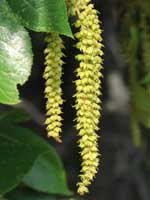 Despite its positive attributes, I had grown increasingly weary of it during the 18 years I’d owned my bungalow. Before mowing the lawn I’d spend 15 or 20 minutes picking up hundreds of twigs and branches. In the spring, the tree would produce a glut of catkins (strands of tiny flowers) that would drop; clog my gutters; and form a thick, dark blanket over grass and sidewalks. Then it would rain and all my concrete would be stained brown for weeks.
Despite its positive attributes, I had grown increasingly weary of it during the 18 years I’d owned my bungalow. Before mowing the lawn I’d spend 15 or 20 minutes picking up hundreds of twigs and branches. In the spring, the tree would produce a glut of catkins (strands of tiny flowers) that would drop; clog my gutters; and form a thick, dark blanket over grass and sidewalks. Then it would rain and all my concrete would be stained brown for weeks.
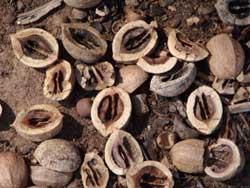 But that’s not all. When the hickory nuts set on in early summer, a horde of squirrels would move in and begin eating them. When I stepped out onto my back stoop, the sound of crunching filled the air. Shell shards rained down on my yard for weeks (and I’m convinced the squirrels aimed them at me). These shards were unsightly and also sharp, so I couldn’t go outside barefoot for the latter half of the summer. What nuts the squirrels didn’t eat, they buried in my lawn, making it a pockmarked mess.
But that’s not all. When the hickory nuts set on in early summer, a horde of squirrels would move in and begin eating them. When I stepped out onto my back stoop, the sound of crunching filled the air. Shell shards rained down on my yard for weeks (and I’m convinced the squirrels aimed them at me). These shards were unsightly and also sharp, so I couldn’t go outside barefoot for the latter half of the summer. What nuts the squirrels didn’t eat, they buried in my lawn, making it a pockmarked mess.
Another find that tipped me in favor of removal was the discovery of Wood From the Hood. Most downed urban trees are chewed up and used as mulch or burned. Wood From the Hood accepts donated urban trees and mills them for lumber to be sold for flooring, furniture and other projects. The owners also make and sell picture frames, cutting boards, and other items.
In the end, for me, the tree’s liabilities far outweighed its advantages. In early April, I called Bratt Tree Company, located just a couple of blocks from my South Minneapolis bungalow. Co-owner Jon Bratt quickly provided an estimate of $1,100—after a $300 off-season discount—to remove the tree and grind the stump out. I was at work during the tree’s denouement and came home to an empty and spotless yard, save for a few indentations where large chunks of the tree must have landed.
A Replacement Tree
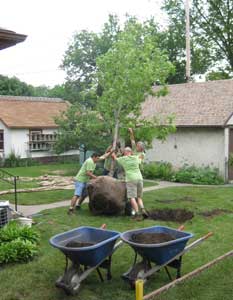
Just as I’ve always thought of grown trees as permanent fixtures, I’ve always thought of new trees as saplings no more than a few feet tall. But if you’re willing to pay, it’s possible to have a tree installed that can actually be called a tree the day it’s planted. My friend Tom Thorson, a landscape architect, suggested a Skyline Thornless honeylocust (Gleditsia triacanthos f. inermis ‘Skyline’). It has a reputation as a good urban tree—unlike some honeylocusts it has no thorns; it can tolerate salt and heat; and once established, is drought resistant. It boasts a strong trunk and grows relatively quickly, reaching a mature height of 50 feet or more. Its small, oval leaves provide lightly filtered shade and generally don’t need to be raked up in the fall.
With the hickory gone, I called the landscape division of Bachman’s Floral Gifts & Garden. A designer paid a visit to my bungalow and pronounced my backyard suitable for a Skyline Thornless honeylocust. She drew up a contract: $862 for a tree, including planting, about 14 feet tall with a trunk 31/2 inches in diameter at chest level.
On June 15, four men rolled the new tree in from the street to my backyard on a wheeled dolly. They dug a hole and muscled the large, burlapped root ball into place. I was happy to see that it’s about 20 feet tall, some 5 feet more than expected.
Second Life
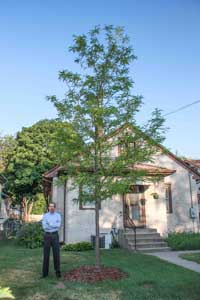 I must admit I felt saddened and a bit guilty the day I came home to find my hickory tree gone. But I cheered up the next time I mowed the lawn without having to pick up 250 sticks first. And I’ve been relieved to see that neighborhood squirrels aren’t spending much time in my yard this summer. And they completely ignore the new tree.
I must admit I felt saddened and a bit guilty the day I came home to find my hickory tree gone. But I cheered up the next time I mowed the lawn without having to pick up 250 sticks first. And I’ve been relieved to see that neighborhood squirrels aren’t spending much time in my yard this summer. And they completely ignore the new tree.
A couple of weeks after the hickory was removed, I ran into Rick and Cindy Siewert, two of the people who operate Wood From the Hood. They told me they had been thrilled to receive the hickory tree, which they say produces beautiful wood that is in high demand.
“When we recycle these trees, they’re given a second life and the chance to continue their legacy,” says Cindy.
Disaster Dodger
Unlike Tim, we loved our tree and were sad to see it go. Luckily, we took it down in the nick of time.
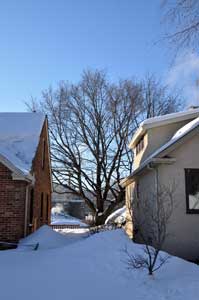 Ours was a Schwedler maple, a variety of Norway maple that begins each season with reddish-green leaves that turn a deep, glossy green as spring becomes summer. It was perfectly situated on the southeast edge of our lot, providing abundant shade for our house, patio, backyard, and garage as well as the neighbor’s backyard. The tree’s rough bark and arching branches created another room. It was the “ceiling” to our patio. It’s where we barbecued, worked on projects together, and took family photos. The hours spent sweeping seeds and raking 15 to 20 bags of leaves every year seemed like a fair trade. (At least in hindsight; maybe not at the time!)
Ours was a Schwedler maple, a variety of Norway maple that begins each season with reddish-green leaves that turn a deep, glossy green as spring becomes summer. It was perfectly situated on the southeast edge of our lot, providing abundant shade for our house, patio, backyard, and garage as well as the neighbor’s backyard. The tree’s rough bark and arching branches created another room. It was the “ceiling” to our patio. It’s where we barbecued, worked on projects together, and took family photos. The hours spent sweeping seeds and raking 15 to 20 bags of leaves every year seemed like a fair trade. (At least in hindsight; maybe not at the time!)
Our tree’s 3-foot-plus diameter trunk gave every appearance of strength and vigor, as long as you didn’t look too closely at the weeping wound on the south-facing surface. While it is rated for Zone 4, the Schwedler maple is vulnerable to “sun scald”—a freeze-thaw-freeze cycle that damages a tree’s living tissue on those sunny, cold winter days.
We nursed it along for over 10 years by pruning the tree’s interior branches to allow the wind to pass through, rather than catch the canopy. We also installed several cable harnesses that would “catch” the major limbs before they crashed into our house or garage or the neighbor’s house or garage. There was only one way the tree could fall without doing major damage, and even then it would have taken out the neighbor’s smaller tree and wiped out power, telephone and cable to half the block. At one time, there were six to eight Schwedler’s on the block—this was the last one.
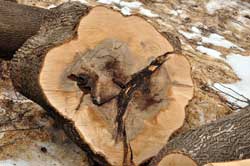 Deciding to remove our maple tree was difficult. We couldn’t have reached the decision without the counsel of our certified arborist, Gary Wemeier of Northern Arborists. As it turns out, our decision was sound. Once the trunk was sliced into sections, we could see the line of rotting wood had nearly isolated a third of the trunk. That third with its adjoining limb could have easily gone down in the next big windstorm.
Deciding to remove our maple tree was difficult. We couldn’t have reached the decision without the counsel of our certified arborist, Gary Wemeier of Northern Arborists. As it turns out, our decision was sound. Once the trunk was sliced into sections, we could see the line of rotting wood had nearly isolated a third of the trunk. That third with its adjoining limb could have easily gone down in the next big windstorm.
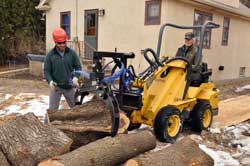 With four buildings within 15 feet of the trunk, removal was a meticulous, branch-by-branch process that took a day and a half. Wemeier recommended a winter removal to minimize damage to the yard as they hauled out the trunk sections and limbs.
With four buildings within 15 feet of the trunk, removal was a meticulous, branch-by-branch process that took a day and a half. Wemeier recommended a winter removal to minimize damage to the yard as they hauled out the trunk sections and limbs.
Future Focus
As we breathed a sigh of relief that this hazard was gone from our yard, we turned to selecting a new tree. We knew we wanted a low-maintenance, native tree that was cold hardy and free of disease and insect problems. We wanted a smaller tree, as the Schwedler maple had been too large and dominant for our small St. Paul yard. And we knew that we didn’t have the best soil. In a perfect world there would be a website where you could enter criteria like these and retrieve a list of trees that would fulfill your needs. We settled for piecing together information from various sources (see resources).
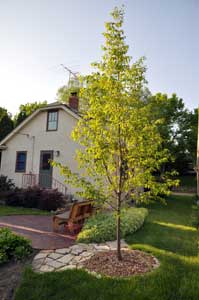 We selected Ostrya virginiana, which has a variety of common names including ironwood, hophornbeam and American hornbeam. In our search we found that using the Latin name was the only way to gather reliable information. (Tip: Make sure your supplier confirms the Latin name of the tree you purchase.) Our tree grew up on the Mississippi River floodplain near Cottage Grove, and Wemeier confirmed it was dug a day or two before re-planting to minimize moisture loss. As a young tree, its shape is oviate to pyramidal—eventually it will spread outward to provide more shade. One of its
We selected Ostrya virginiana, which has a variety of common names including ironwood, hophornbeam and American hornbeam. In our search we found that using the Latin name was the only way to gather reliable information. (Tip: Make sure your supplier confirms the Latin name of the tree you purchase.) Our tree grew up on the Mississippi River floodplain near Cottage Grove, and Wemeier confirmed it was dug a day or two before re-planting to minimize moisture loss. As a young tree, its shape is oviate to pyramidal—eventually it will spread outward to provide more shade. One of its
curious features is that the bark tends to exfoliate or shred in thin strips.
Choosing a location for the new tree became fairly simple. We wanted the new tree to give us shade in the same way our maple had. We had conversations with our neighbors about where it would go—something we would highly recommend. Due to the small size of the backyard, the power and telephone lines, the property line, and the location of the garage and patio, there really was only one spot—about 4 feet from the old tree.
We really like the new tree and no longer dread windstorms. Taking down our old maple was difficult due to the closeness of buildings, so removal cost over $2,000. Purchasing and planting the new tree cost about $600. It was money well spent.
Resources
Northern Arborists, Lake Elmo
Gary Wemeier
651-436-3467
www.northernarborists.com
Bratt Tree Company
2230 E. 35th St., Minneapolis
612-721-4153
www.bratttree.com
Wood From the Hood
612-581-0252
www.woodfromthehood.com
Bachman’s landscape division
612-861-7646
www.bachmanslandscaping.com
Minnesota Power:
“The Right Tree Brochure”
www.mnpower.com/treebook
University of Minnesota
• Extension: Garden, Trees and Shrubs
http://tinyurl.com/94cqfxb
• Urban Natural Resources
http://tinyurl.com/9sffb4r
Xcel Energy:
Tree Selection, “Plant a Better Future”
http://tinyurl.com/8qbkmuo











